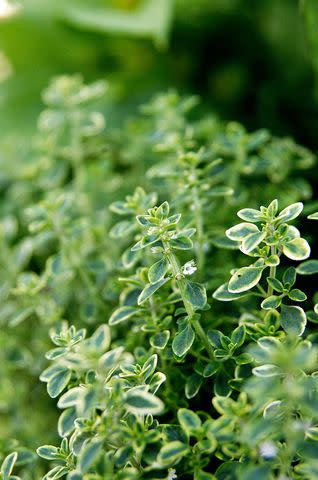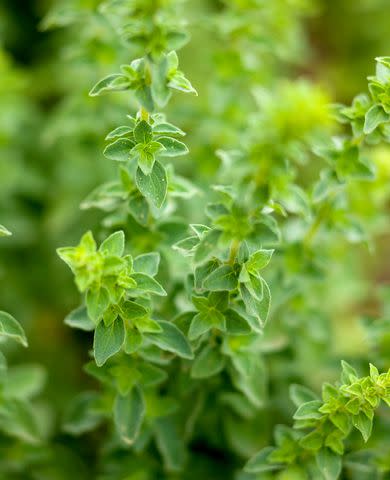9 Delicious Herbs You Can Grow in Water

Several herbs can grow for months in nothing but water. It's an easy way to propagate them from your garden, and you can keep your fresh herb supply going in winter, just by bringing a few sprigs indoors before the frost arrives.
Just snip 4- to 6-inch long stems from any of the following plants, remove any leaves from the bottom half, and place the bare stems in water. Keep the cuttings on a sunny windowsill and change the water every few days. If you intend to plant them, once the roots are a couple of inches long, move your cuttings into containers of potting mix.
Thyme

Although thyme has tiny leaves, it packs some big flavor. The best time to root cuttings from this perennial herb is between mid-spring and early summer, when the plant is producing fresh, new growth. Make your cut just below a node, which is the part of a stem from which leaves sprout. Your thyme stems should start rooting about two weeks after being placed in water.
Mint

By growing mint in a jar of water, you can always have some ready for adding to your favorite drinks or dishes, without the worry of this vigorous plant taking over your garden. For example, you can amp up your cocoa or tea with a sprig of peppermint or brighten up fruit salad with julienned spearmint. Mint stems will root quickly, and can last quite a while indoors in water if they're in a brightly lit spot.
Oregano

Practically synonymous with Italian cuisine, oregano is a must-have herb for pasta sauces and homemade pizza. Oregano plants can get woody as they age, so take your cuttings from fresh, new growth that still has green stems, as they'll root more easily. To keep your oregano as flavorful as possible, remove any flower buds that appear.
Basil

One of the most popular herbs, basil comes in all sorts of varieties and is endlessly useful in the kitchen. Turn big bunches into a quick pesto sauce, or throw the leaves in a tomato-based soup or summery salad. Even just a leaf or two can liven up a glass of lemonade. Take basil cuttings in early summer, before the plants begin to flower. The stems will root easily in water, but to get the best leaf growth, plant your cuttings in soil once the roots reach about two inches long.
Rosemary

Another classic herb, rosemary adds distinctive flavor to savory as well as sweet dishes. You can also use it to make a natural air freshener when you combine it with a little lemon and vanilla. Similar to oregano, rosemary stems can get woody with age, so make sure to cut fresh, green stems to propagate in water. This plant can be a bit slow to form roots, so if you want to speed up the process, try dipping the cut end in rooting hormone ($11, Walmart) before you place it in water.
Sage

What would Thanksgiving stuffing be without sage? Definitely not the same. For the best results rooting in water, take your sage cuttings from new growth in the spring. This plant can be prone to rotting, so it's especially important to change the water frequently, and don't allow any of the leaves to get wet.
Lemon Balm

Herbal tea is even more special with the hint of lemon this herb supplies. Propagating lemon balm cuttings in water can require patience. It may take up to a month for roots to appear. Once they do, let the roots grow a couple of inches, then move your cuttings into soil.
Lavender

Loved for its fragrance and flavor, lavender lends itself to sweets, such as cookies and ice cream, as well as to hearty main dishes, such as lamb chops. This hardy perennial herb makes a beautiful addition to gardens, especially when it's in bloom. Cuttings can be slow to root, so to help the process along, dip the cut ends in rooting hormone before placing them in the water.
Marjoram

Closely related to oregano, marjoram has a similar robust flavor, yet tastes sweeter than its cousin. Marjoram also remains smaller than oregano, so it can be better suited to growing indoors. However, have patience—in water, it can take up to two months for the stems to sprout roots.
false